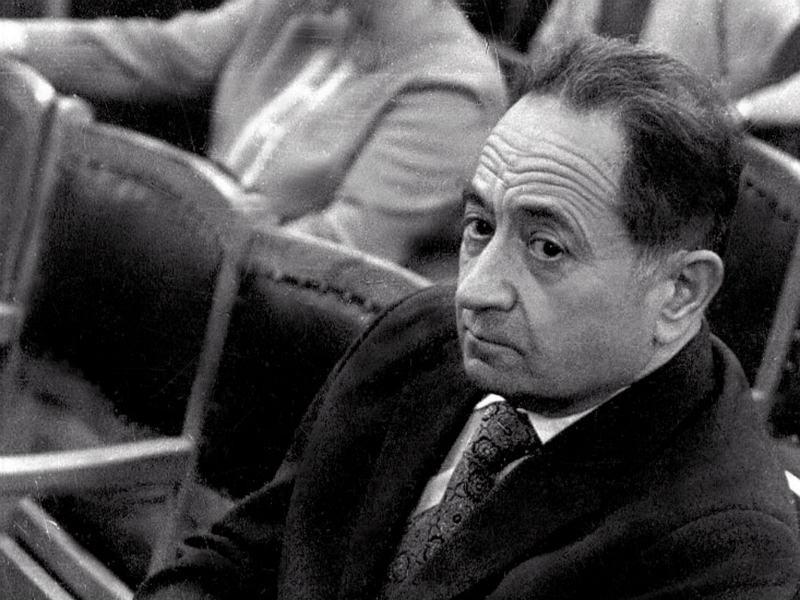Music composed by Jewish Ukrainian artist Dmitri Klebanov and suppressed by the Soviet authorities from the 1940s until 1988 was recently rediscovered.
Born in Kharkiv, Ukraine, in 1907, Klebanov wrote nine symphonies, several string quartets, concertos, operas, ballets and about 100 songs, but only one of his works was ever recorded. Most of his compositions survive in manuscript form.
A year ago, the ARC (Artists of the Royal Conservatory) Ensemble, which performs works censored under fascism and communism, acquired manuscript copies of some of Klebanov’s chamber music and songs. The music will be featured at the ensemble’s upcoming concert in Toronto on Nov. 17.
“I’m pretty sure that everything on our program will be enjoying its first performance in 70 years,” said Simon Wynberg, the group’s artistic director.
Klebanov’s first symphony, dedicated to the “memory of the martyrs of Babi-Yar,” a ravine near Kyiv where nearly 34,000 Jews were murdered by the Nazis in September 1941, was well-received in Ukraine and Klebanov seemed destined for career success.
But the Soviet Union’s artistic heartland was Moscow, where the symphony was in rehearsal in 1949, until it was deemed unpatriotic for focusing on Jewish victims rather than Soviet casualties.
The performance was banned, Klebanov was denounced and doors quickly closed to him.
“In isolating Jews and specifying they were Jews rather than members of the Soviet Union, you were kind of giving them a special preference,” said Wynberg. “You were a Soviet citizen first, and to isolate Jews as being particularly hard done by was an insult to the Soviet Union.”
Despite the dedication, the only music of Jewish origin in the symphony is a passage for solo oboe in the final movement that sounds like a shofar, and a mezzo-
soprano solo.
“This was pure anti-Semitism,” added Wynberg.
Anti-semitism was rampant in the Soviet Union after 1948. In a campaign against “rootless cosmopolitans” – a code phrase for Jews – several poets, writers, painters and sculptors were arrested or shot.
The person who denounced Klebanov had written a complimentary article about the symphony three years earlier. “In three years, the person thought it was the right thing to do in terms of saving their own skin or being on the ‘right’ side,” Wynberg said.
“It just goes to show how scared people were. It’s difficult to imagine now that your very existence could depend on the kind of music you wrote.”
READ: BIRTH OF DAUGHTERS GAVE SINGER NEW PRIORITIES
After he was denounced, Klebanov lost his position as the head of the Kharkiv chapter of the Union of Soviet Composers. “Certainly any activities outside Ukraine became much less of a possibility. He was still teaching, but any opportunities to have his music disseminated and published became fewer and fewer,” Wynberg said.
Socialist realism was the official artistic style in the Soviet Union from 1932 to 1988. “The idea was that you would use music as a vehicle to improve the lives of the worker,” Wynberg said. “People got into trouble when they ran against those principles in any kind of major way.”
The restraints on Klebanov, who died in 1987, were loosened in the 1960s, during the Khrushchev era, but Klebanov never got complete artistic freedom. “He managed to acquire some currency in the Ukraine, but not much outside it,” Wynberg said.
Klebanov’s son, Uri, who lives in Moscow, told Wynberg that, in a sense, his father was fortunate. “He was very lucky to escape as lightly as he did, with a career in ruins rather than a bullet,” Uri Klebanov said.
The ARC Ensemble presents Klebanov’s works at a free concert on Nov. 17 at 7:30 p.m. at the Mazzoleni Concert Hall in the Royal Conservatory of Music, 273 Bloor St. W., Toronto. For tickets, visit rcmusic.com/events-and-performances.
